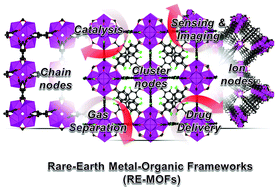Rare-earth metal–organic frameworks: from structure to applications
Abstract
In the past 30 years, metal–organic frameworks (MOFs) have garnered widespread attention owing to their diverse chemical structures, and tunable properties. As a result, MOFs are of interest for a wide variety of potential applications spanning multiple scientific and engineering disciplines. MOFs have been synthesized using several elements from the periodic table, including those with metal nodes containing s-, p-, d-, and f-block elements. MOFs synthesized with rare-earth (RE) elements, which include scandium, yttrium and the series of fifteen lanthanides are an intriguing family of MOFs from the standpoint of both structure and function. While RE-MOFs can possess many of the same properties common to all MOF families (i.e., permanent porosity, tunable pore size/shape, accessible Lewis acidic sites), they can also display unique structures and properties owing to the high coordination numbers and distinct optical properties of RE-elements. In this review, we present the progress, and highlight several discoveries from research conducted on the topic of RE-MOFs. First, diverse structures of RE-MOFs are presented, divided into classes based on the composition of the RE-metal node being RE(III)-ions, RE(III)-chains, or RE(III)-clusters. Then, several potential applications of RE-MOFs are presented, highlighting examples in the areas of chemical sensing, white light emission, biological imaging, drug delivery, near infrared emission, catalysis, gas adsorption, and chemical separations.

- This article is part of the themed collection: 2020 Emerging Investigators


 Please wait while we load your content...
Please wait while we load your content...